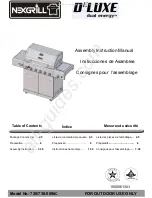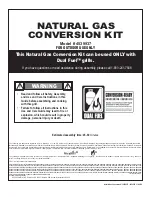
CARE & USE/INSTALLATION
|
23
Outdoor grills create more heat than interior kitchen
ranges. That’s how they sear and grill steaks and other
foods.
These high-performance burners require a constant, steady
supply of fresh air to mix with the fuel. Your Lynx grill pulls air
in through the front and vents hot gases out through the rear.
Using your grill in windy conditions may disrupt the front-
to-back air flow. If, while grilling with all burners on high
and the hood closed, you notice that the temperature
gauge fails to rise ... be careful. If wind has kept hot gases
from exiting the rear of the grill the control panel and knobs
may have become extremely hot.
Your Lynx grill features an exclusive, patent-pending Heat
Stabilizer that will deflect wind and, in most cases, prevent
this situation.
But there are a few things you can do to further
prevent
the possibility of improper heat buildup:
• On breezy days, be careful not to leave the front
hood down when the burners are on high if the is grill
unattended.
• If you suspect the grill is overheating, using an oven mitt,
open the front hood. Then adjust the burner control knob
to a lower setting.
• Install your grill with a wind break behind it.
• Orient the grill so prevailing winds are not blowing into
the rear of the grill.
GRILLING IN WINDY CONDITIONS
Wind hitting the back of the grill can
disrupt proper exhaust.
Air enters through the front of the grill.
Please Note:
Any damage caused from use in windy conditions, such as melted knobs or igniter wires,
or control panel discoloration from heat buildup, is excluded from warranty coverage.
IMPOR
TANT!
Summary of Contents for L27 Series
Page 1: ...CARE USE INSTALLATION MAKE THE MOST OF YOUR ...
Page 2: ......
Page 40: ...40 CARE USE INSTALLATION L27 L30 ROTISSERIE GRILL WIRING SCHEMATICS ...
Page 41: ...CARE USE INSTALLATION 41 L36 L42 ROTISSERIE GRILL WIRING SCHEMATICS ...
Page 42: ...42 CARE USE INSTALLATION L54 ROTISSERIE GRILL WIRING SCHEMATICS ...
















































